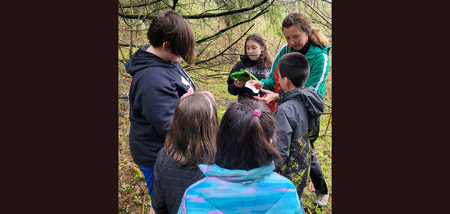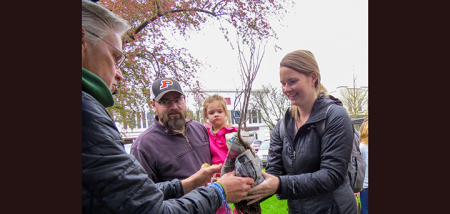Project Chenango: Chenango’s Agricultural Economy
Published:
October 15th, 2015
By Melissa Stagnaro
Special to The Evening Sun
stagnaro.melissa@gmail.com
CHENANGO – As both the daughter and granddaughter of a farmer, Liz Bunce knows first hand the pride of seeing the tangible results of agricultural labor. There’s a certain satisfaction in seeing milk in the bulk tank or a crop harvested, she said.
Or, in her case, the chance to sample a craft beer made from her own hops.
Bunce is the first to admit she didn’t fully appreciate the benefits of growing up on a dairy farm or living in a small community like Oxford. In fact, she says she couldn’t wait to leave both behind when she graduated from high school.
But after returning to the area and working in corporate America, she has a different perspective.
“I missed that connection to the land,” she explained.
Her chance to renew that connection came about six years ago, when her parents decided they were ready to retire from dairy farming. As they discussed estate planning and how to keep the Hoffman’s 160-acre farm in the family, it was Bunce rather than her older brother who raised her hand.
“I had been wanting to get back into farming for awhile,” she said.
But while Bunce was interested in carrying on the family’s farming legacy, she knew dairy wasn’t for her.
She asked herself a question: “What can I do to keep the farm in the family without living there?”
She has found her answer in an up-and-coming crop that was once a mainstay of the region’s agricultural heritage: hops.
“I knew that there was a history here, but I didn’t learn a lot about it until I decided to grown them,” she said.
She chose to name her venture Hillside Hops, in keeping with the farm’s name, Hillside Acres. The name is also apropos for another reason: the 8-acre parcel of land her father initially earmarked for her use was a steep side hill that hadn’t been in production for 30 years.
The challenging terrain did nothing to deter Bunce’s drive and determination to make her venture a success. She geared up by taking part in the Beginning Women Farmer’s program, a grant-funded program she described as business 101 from a different perspective.
“I stared small,” she said. Her first planting consisted of two varieties and a total of 75 plants. One of the reasons she chose hops, she said, is because they are self-perpetuating. Meaning she doesn’t have to go through the labor or expense of replanting each year. Instead, she’s steadily grown the operation. She’s added a third variety, and as of her fourth harvest, is approaching 200 plants.
Her growth has been slow, but that’s by choice. Rather than expand more rapidly, she invested in a piece of pelletizing equipment that will be both beneficial to her operation and allow her to diversify.
“Right now there are only a few places in New York where (growers) can get their hops pelletized,” she explained. Growers must transport their hops to these facilities, a process which can damage them.
With the mobile unit she purchased, Bunce will be able to both pelletize her own hops, and also help other growers. She’s working to obtain a special permit from New York State to put her plan into action.
Currently, she sells the majority of her hops to FarmHouse Brewery in Owego. She’s confident that as she increases her yield she’ll find a ready market for her hops with other breweries as well.
“There is such demand in New York,” she said. This is due in part to a stipulation in Governor Cuomo’s Farm Brewery legislation requiring breweries to source a certain percentage of their ingredients from New York.
“It’s created a ripple effect,” she explained, which is helping support not only the hops industry but other producers as well.
For now, Hillside Hops is a part-time venture for Bunce. She works it on nights and weekends around her full-time position with Commerce Chenango. As the business advocacy group’s economic development specialist, part of her role involves working with other ag producers and agri-businesses as well as on agricultural-related initiatives. But balancing the two requires long days.
“What keeps me going is that farming is how I end my day,” she said.
It’s an opportunity to not only do what she loves, but also work toward her more holistic goals. Those goals are to preserve an agricultural heritage in Central New York; promote a healthy, holistic use of land; and bring ethical products to market – all in partnership with area businesses and the community.
It’s a community in which Bunce now realizes how lucky she is to be a part, as she says they’ve shown incredible support for both her and her brand of agricultural entrepreneurship.
“I think there is an opportunity for embracing the agricultural heritage here, but to try something new,” she explained.
DIVERSIFYING DAIRY
On the other end of Oxford, John Marshman shared a similar belief.
“Farms are like entrepreneurs,” he said. “Each generation must reinvent the farm business.”
Marshman and his brother David are the sixth generation to farm Marshman Farms, LLC since it was founded 1856. At 900-acres, milking 420 head, they are one of the largest dairy farms in Chenango County. The farm supports 10 families, including those of its employees.
The farm’s continued growth despite the tough economic climate is due in large part to how the brothers have reinvented the farm’s business model. They’ve succeeded in both expanding the farm to its current production levels, and diversifying by breeding purebred Holsteins.
They market these purebred Holsteins under the name Tiger Lily Holsteins. They’ve created a high demand by choosing to specialize in red and white (as opposed to black and white) cows, as well as polled (naturally hornless) cattle. According to Marshman, the red and whites are popular show cows, and a bull from their breeding is currently a popular sire.
The market for Tiger Lily Holsteins is a global one. In the past, they’ve shipped cattle and embryos as far as China, Russia and Turkey. Currently, their largest market is Europe.
The global nature of the market does create challenges.
“We are doing business in a global economy,” Marshman explained. “Even though we are a local business, much of our income and expense are dictated by the global economy.”
Where does Marshman see the future of the farm?
“The future of every farm depends on the people involved,” he said. “A goal is to continue to recruit and employee both family and non-family employees who have a passion for agriculture and will continue to move the business in a positive direction.”
THE IMPORTANCE OF AGRICULTURE
Not all farms have been able to weather the economic climate as well as the Marshmans. According to the USDA’s 2012 Census of Agriculture, Chenango County lost 80 farms between 2007 and 2012. With the disappearance of those farms, 10,000 acres of farmland has been taken out of production.
“Once the farms are subdividied, that’s period, end of sentence,” said Bradd Vickers of the Chenango County Farm Bureau.
Vickers can list a number of factors that are contributing to the demise of family farms, starting with regulatory burdens at both the state and federal level. A complicated milk-pricing system that lacks transparency and seems to flout the basic economic principles of supply and demand is another.
The state of the economy as a whole also impacts farmers, he explained. In some ways farmers may be even more susceptible to these market forces.
“Because farmers are buying at retail and selling at wholesale, and the perishable nature of the product, farmers are generally price takers instead of price setters,” Vickers explained.
Despite these challenges, agriculture remains the largest industry in Chenango County.
“Farming has been the leading activity in Chenango County for 200 years and it is not going anywhere as long as we have rain and soil and farmers,” said Ken Smith, executive director of Cornell Cooperative Extension of Chenango County.
“Other industries have come and gone, (but) farming is the one constant.”
Despite the downward trend, 812 farms are currently still in business. They represent a combined 167,000 acres and contribute just shy of $66 million to the county’s economy annually, Smith said. And the ripple effect is much larger than that.
The dairy industry accounts for $59 million of that total, roughly 90 percent of the county’s total farm receipts. $42 million of that is from milk sales, he explained, with the remaining $17 million derived from sales of beef, crops and other ancillary products.
“That is just the amount of products sold,” he clarified.
Cornell research indicates the true impact is 1.7 times that, or approximately $100 million.
“That does not take into account Chobani,” he added.
Agriculture’s impact on the region isn’t only about the economics, according to Smith.
“Farming still shapes the landscapes and is the back drop for everything around us, even though we are not always conscious of the plowing, planting and harvesting that is constantly going on,” he said.
“It is there in the background, just as the changing seasons are.”
OPPORTUNITIES
Despite the challenges faced by the entire agricultural industry, those interviews expressed a certain degree of optimism about the future of the agriculture based on current opportunities and trends.
For Marshman, it’s about natural resources.
“We have the ability to plant and harvest high quality forages. In addition, we have an abundance of water,” he said. There also isn’t the development pressure felt in some areas of the country.
In Smith’s opinion, it’s the proximity to major metropolitan areas.
“The biggest opportunities are connecting to the nearby big city markets in places like Boston, New York and Philadelphia,” he explained.
Already, producers like Norwich Meadow Farms and Fantasy Fruit Farm are having success in these markets. But some producers have not been able to access them either due to transportation constraints or the lack of certified processing facilities in the region.
“It’s frustrating when you are less than 400 miles away from the best markets on the East Coast and see other states working around you and hitting that market,” Vickers said, referring to the lack of rail in Chenango.
Bunce said there are conversations taking place on the regional level about creating a food hub. This would be a centralized location where producers and growers could bring their products and those goods would then be transported together to one of those metropolitan markets.
According to Bunce, there are also potential projects in the works that, if they each reach fruition, would give area producers access to a ‘maker’s space’; produce processing; and a USDA-certified meat processing facility. Currently, most local producers have to go to Pennsylvania to have their meat processed in a certified facility, she said.
All of these initiatives are primarily aimed at helping producers connect with those large markets, but will also help reinforce the connection with local consumers.
“The locavore movement is growing in popularity right now,” Bunce said, referring to the greater interest consumers are taking in where their food comes from, and the effort they are making to buy locally grown and produced food. The resurgence in farmers markets throughout Central New York is further evidence of this.
“That trend nationally, and certainly locally, is an opportunity for producers in Chenango,” she said.
Rotational grazing is another opportunity.
“Grazed milk … could be a pivotal crop for Chenango County farmers because it is a product that is particularly suited to our resources, infrastructure and work force,” Smith said. “It is one area where we can really compete on a regional scale.”
The extension agent also sees the influx of Amish into the county as a positive for agriculture and the community in general.
“They are taking over farms that were not producing anything but scrub brush and making very good farms of them,” he said.
THE FUTURE OF FARMING
The rise of the use of automation and robotics could very well be another boon for agriculture, according to Smith. Especially when it comes to growing fruits and vegetables and specialty crops such as blueberries and raspberries.
“They won’t replace the farmer,” he said, “but they will make a lot more kinds of farming viable in our region that we cannot do now due to high labor costs.”
While technology will definitely play a role, it’s impossible to discuss the future of farming without talking about the future farmers themselves.
Vickers has been working with a new demographic in this regards: veterans.
A veteran himself, Vickers is involved with the Veterans and Farmers Alliance. Their goal, he said, is to connect combat veterans with agriculture. It is a calming environment where they can apply a lot of their existing skills, he explained. A 3-year grant will enable them learn the agriculture-specific skills they will need.
“I’m getting a fair number of calls from veterans who own property, or who are looking to work with someone who does,” Vickers said.
He’s also heard of a vendor at one of New York City’s green markets that has already creating a buzz by selling items marketed as “Homegrown by Heroes.”
Marshman advocates for education on both the high school and collage level, citing the importance of programs like 4-H and the agricultural programs at Afton, Oxford, Unadilla Valley and Otselic Valley. These all help students not only gain an understanding of agriculture, but also lay the foundation for a future career in farming.
“Educating and encouraging our youth to pursue advanced degrees in agriculture at institutions of higher education such as Cornell University or Morrisville State College is imperative to the continued success of Chenango County’s agricultural industry,” he said.
Regardless of whether they intend to pursue a degree or career in agriculture, education is still important.
“Human capital is our great resource,” said Marshman. “We must continue to educate people of the many benefits of modern agriculture.”
Comments







